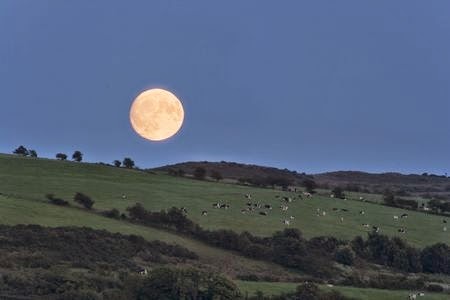Ever noticed an unusually low and golden-coloured moon in the autumn? Here in the northern hemisphere we saw one last night, and with any luck we should be able to do so again tonight. It's commonly referred to as a Harvest Moon, though it comes by other names in different cultures. It's quite a sight and leaves you wondrous at the beauty of nature.
Why the name?
The name Harvest Moon refers to the full moon which appears nearest the autumnal equinox. Although every full moon has its own name (the full moon due on 8 October 2014 is the Hunter's Moon), the Harvest Moon is probably the most well-known. It is thought to have been named after the abundance of bright moonlight available on these few nights in early autumn, which has traditionally assisted farmers by providing more light by which to harvest their crops.
Why does it look so big?
The Harvest Moon rises earlier than usual – shortly after sunset – because of its northerly trajectory, which means it is lower down on the horizon. This has two effects – firstly, that the moon appears much larger and secondly, that the moon appears orange in colour. Its beautiful colour is in fact down to the way in which the spectrum of light is filtered by the earth's atmosphere. Sunset takes on the same attribute – when looking at the horizon the atmosphere is much thicker there and more of the blue light is scattered, making the red light more visible. This gives both sunset and a Harvest Moon its strong warm colours.
A time to think
So take time to appreciate the full moon in all its glory tonight. For many cultures it's a time of great celebration and some people look upon a full moon as a new start. At Harvest we think it's important simply to take the time to pause for a few moments, to appreciate nature and the world around us in all its splendour.
09 September 2014
Subscribe to:
Post Comments (Atom)





No comments:
Post a Comment